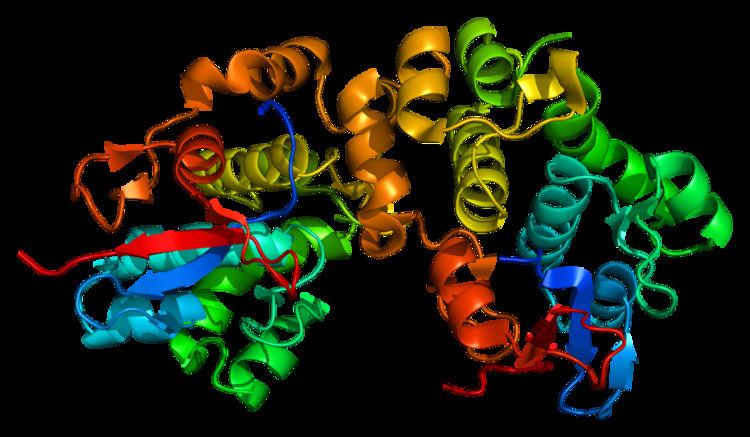Entrez 1832 | Ensembl ENSG00000096696 | |
 | ||
Aliases DSP, DCWHKTA, DP, DPI, DPII, desmoplakin External IDs OMIM: 125647 MGI: 109611 HomoloGene: 37922 GeneCards: DSP | ||
Desmoplakin is a protein in humans that is encoded by the DSP gene. Desmoplakin is a critical component of desmosome structures in cardiac muscle and epidermal cells, which function to maintain the structural integrity at adjacent cell contacts. In cardiac muscle, desmoplakin is localized to intercalated discs which mechanically couple cardiac cells to function in a coordinated syncytial structure. Mutations in desmoplakin have been shown to play a role in dilated cardiomyopathy, arrhythmogenic right ventricular cardiomyopathy, striate palmoplantar keratoderma, Carvajal syndrome and paraneoplastic pemphigus.
Contents
Structure
Desmoplakin exists as two predominant isoforms; the first, known as "DPII", has molecular weight 260.0 kDa (2272 amino acids) and the second, known as "DPI", has molecular weight 332.0 kDa (2871 amino acids). These isoforms are identical except for the shorter rod domain in DPII. DPI is the predominant isoform expressed in cardiac muscle. The DSP gene is located on chromosome 6p24.3, containing 24 exons and spanning approximately 45 kDa of genomic DNA. Desmoplakin is a large desmosomal plaque protein that homodimerizes and adopts a dumbell-shaped conformation. The N-terminal globular head domain of desmoplakin is composed of a series of alpha helical bundles, and is required for both the localization to the desmosome and interaction with the N-terminal region of plakophilin 1 and plakoglobin. This is further sub divided into a region called the "Plakin domain" made up of six spectrin repeat domains separated by SH3 domain. A crystal structure of part of the plakin domain has been resolved, while the entire plakin domain has been elucidated using small angle X-ray scattering which revealed a non-linear structure, an unexpected result considering spectrin repeats are observed in linear orientations. The C-terminal region of desmoplakin is composed of three plakin repeat domains, termed A, B and C, which are essential for coalignment and binding of intermediate filaments. Located at the most distal C-terminus of desmoplakin is a region rich in glycine–serine–arginine; it has been demonstrated that serine phosphorylation of this domain may modify desmoplakin-intermediate filament interactions. In the mid-region of desmoplakin, a coiled-coil rod domain is responsible for homodimerization.
Function
Desmosomes are intercellular junctions that tightly link adjacent cells. Desmoplakin is an obligate component of functional desmosomes that anchors intermediate filaments to desmosomal plaques. In cardiomyocytes, desmoplakin forms desmosomal plaques with the intermediate filament desmin, whereas in endothelial cells cytokeratin type intermediate filaments are recruited, and vimentin in arachnoid and follicular dendritic cell types. Both types of intermediate filaments attach in a lateral fashion to desmoplakin to form the plaque. In cardiac muscle, desmoplakin is localized to desmosomes in intercalated discs. Desmoplakin isoform DPI is highly expressed and is thought to play a role in both the assembly and stabilization of desmosomes; its role is critical, as desmoplakin knockout mice display embryonic lethality. In mice overexpressing a C-terminal mutated desmoplakin protein, desmoplakin binding to desmin is disrupted in cardiac muscle and hearts display abnormal intercalated disc formation and structure. Much has been learned regarding desmoplakin function from mutations in patients with arrhythmogenic right ventricular cardiomyopathy, where mutations in specific binding domains alter desmoplakin binding to plakoglobin or desmin and result in cell death and dysfunction.
Clinical Significance
Mutations in this gene are the cause of several cardiomyopathies, including dilated cardiomyopathy and arrhythmogenic right ventricular cardiomyopathy. Mutations in DSP have also been associated with striate palmoplantar keratoderma. Carvajal syndrome results from an autosomal recessive mutation of a frameshift (7901delG) in DSP that results in a combination of above conditions, including dilated cardiomyopathy, keratoderma and woolly hair. Patients with Carvajal syndrome often suffer from heart failure in teenage years. A case of compound heterozygosity for two DSP nonsense mutations resulting in lethal acantholytic epidermolysis bullosa has been reported. Autoantibodies to DSP are a hallmark of the autoimmune disease paraneoplastic pemphigus. Decreased desmoplakin expression has been found in patients with oropharyngeal cancer and breast cancer, which may alter cell-cell adhesion properties and propagate metastasis.
Interactions
Desmoplakin has been shown to interact with:
